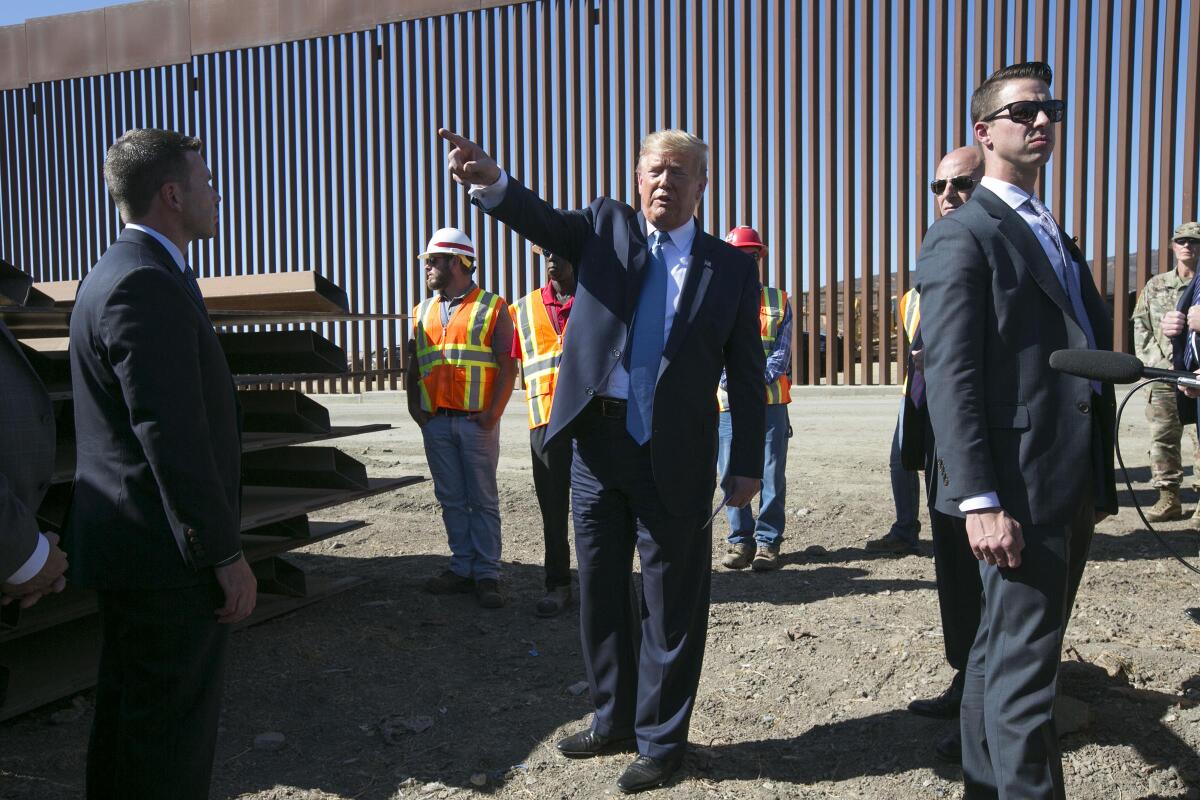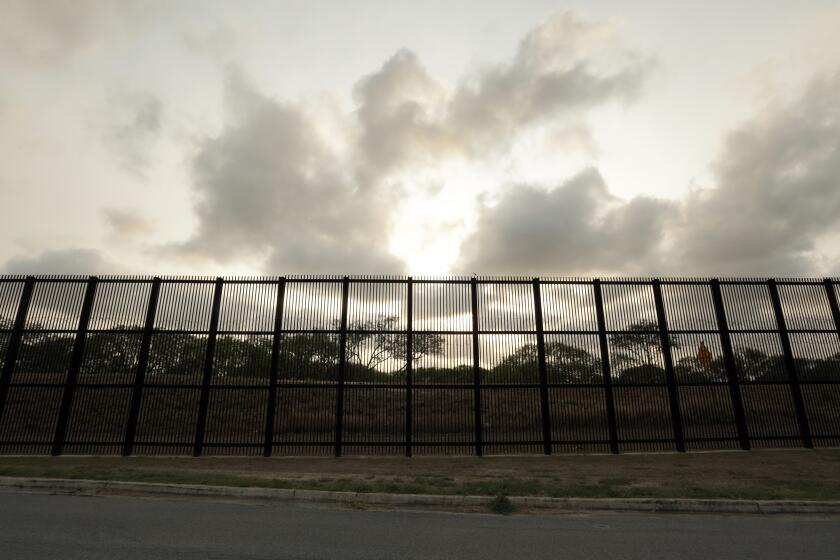Column: Is ‘pregnable’ a word? If so, that’s what Trump’s border wall is

- Share via
My first reaction to the news that Mexican smuggling gangs have cut through Donald Trump’s supposedly impregnable border wall more than 3,000 times was to laugh out loud.
According to an investigation by the Washington Post, the gangs use cheap power tools available at any hardware store. The cuts are made near the bottom of the fencing, severing the steel beams — known as bollards — from the concrete they’re embedded in. At that point, they’re left dangling, connected only at the top. They can then be pushed aside, creating a gap wide enough for people and drugs to pass through. The U.S. government has spent $2.6 million to repair the cuts between 2019 and 2021.
I laughed because, I mean, weren’t we all waiting for this moment when Trump’s ill-thought-out idea was definitively shown to be as foolish as it always seemed? I admit to taking a measure of eye-rolling satisfaction in that.
But then I caught myself. The border wall — and what it has come to represent in American politics — is no joke and shouldn’t be treated as one. This is more than a schadenfreude moment.
Opinion Columnist
Nicholas Goldberg
Nicholas Goldberg served 11 years as editor of the editorial page and is a former editor of the Op-Ed page and Sunday Opinion section.
Trump, you will remember, was swept into office in 2016 on a promise to build a barrier along the 1,954-mile-long U.S.-Mexican border. When he left office in 2021, he had built 458 miles out of a planned 738 miles of barrier — mostly tall metal fencing, including 77 miles in California. Much of that was in places where some kind of barrier had previously existed, although the Trump version is generally bigger and more imposing.
Trump’s initial promises that Mexico would pay for the wall’s construction never came to pass. Instead, U.S. taxpayers spent about $11 billion on the project; in some places it cost more than $40 million per mile. Trump also insisted that his “big beautiful wall” would be “virtually impenetrable.”
From the start, critics said rightly that it would be ineffective and ludicrously costly.
But what always was most insidious about Trump’s wall was the way it became a symbol and a physical embodiment of his broader message: America is endangered. The American dream itself is under siege from within the country and without.
Rapists! Criminals! Drug smugglers! Terrorists! That’s who was massing at the southern border in Trump’s mind — dark, dangerous outsiders from Mexico, along with other undesirables from “shithole” countries.
Overlooked in the days since Trump’s celebration of Putin’s invasion of Ukraine is how wrong Trump was about the man he claims to know “very, very well.”
His wall, running 18 to 30 feet tall in four states, was a sort of anti-Statue of Liberty, a visible declaration of our new attitude to the world: You can keep your huddled masses; Trump is protecting us now from carnage in our cities, corruption in our government and the border hordes.
Interestingly, the wall was originally just a Trump talking point — invented by political advisors Roger Stone and Sam Nunberg as a mnemonic device to remind the builder-turned-candidate to talk about illegal immigration in his speeches.
But on the campaign trail, the proposal electrified supporters. “Build the wall! Build the wall!” crowds shouted exuberantly. It became Trump’s signature election promise because it was such a perfect metaphor.
The wall was unnecessary. It was racist. It was unworkable for many reasons. It wasn’t even really a wall; it was a fence. But politically, it was brilliant.
And it remains a potent symbol. Just last week, long after its construction was halted by the Biden administration as “a waste of money” and a diversion from “genuine threats,” two conservative House Republicans, Lauren Boebert (R-Colo.) and Marjorie Taylor Greene (R-Ga.), tried to undermine Biden by starting a chorus of “Build the Wall” during his State of the Union address.
That’s why the Post’s reporting was important. The wall is not impenetrable; it is not what was promised; it’s a fiction.
These technologies are just as deadly as Trump’s wall — with greater potential for abuse.
Last March, smugglers cut an opening in Trump’s bollard wall so broad that two SUVs filled with migrants were able to drive through. (One later hit a truck near Holtville, Calif., killing 13.) Maintenance records kept by Customs and Border Protection show the bollards are cut most often in California. The Border Patrol’s El Centro sector has recorded the most breaches, 1,867; the San Diego sector ranked second, with 866.
Also, by the way, people are climbing up and over the wall using makeshift ladders or ropes.
The reasons for surges and declines in illegal immigration are complicated. But this much is clear: Despite the wall, migrants are still crossing the border without authorization in enormous numbers.
House Speaker Nancy Pelosi once said publicly about the wall: “It’s not who we are as a nation.” She also said privately about Trump: “It’s like a manhood thing for him.”
Unfortunately, the “Build the Wall” nonsense can’t yet be written off as ancient or forgotten history. Late last month, Trump gave his clearest indication to date that he intends to run for president again in 2024.
“We did it twice and we’re going to be doing it again,” he said at the Conservative Political Action Conference in Orlando, Fla. (Yes, even though the reality-based world knows he won only once, not twice, Trump continues to impose his delusional, counterfactual history on his listeners.)
And can there be any doubt that if he comes back into power, his big, nasty, but symbolically potent border project will come back with him?
More to Read
A cure for the common opinion
Get thought-provoking perspectives with our weekly newsletter.
You may occasionally receive promotional content from the Los Angeles Times.














